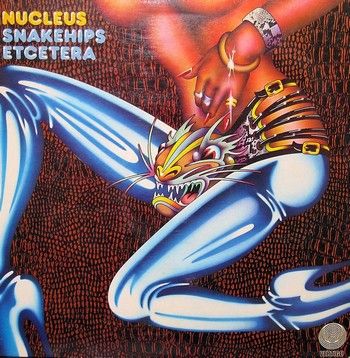
Nucleus - Snakehips Etcetera - 1975 - Vertigo
"Snakehips Etcetera" was never regarded as one of Ian Carr & Nucleus' strongest albums. Bob Bertles "Rat's Bag" has been called "cliché-filled half-funk". The album has also been called "predictable". One review described the album as "a corny album, a dirty album, a cool album, with a few sporadic hints of grit, but lacking punch" Make what you like out of that ! On 'Snakehips Etcetera', Nucleus was reduced to a sextet with Ian Carr doubling on moog, and piano. Bertles, Shaw, and Castle are still in this '75 Nucleus formation. Roger Sutton on bass and percussion, and Roger Sellers on drums and percussion, make up the "new" rhythm section. "Rat's Bag" is great funky fusion with Ian Carr blowing some great trumpet and Geoff throwing in some classy clavinet. The horn parts are overdubbed very well, giving the impression that there are more than two horns on the tracks. The melodies may be less cerebral than other Nucleus albums, but they are infectious, and will grab you just as much as any of Nucleus' other album tracks. "Alive and Kicking" begins with what sounds like sampled vocals, and Bob Bertles plays some great "snaky" soprano sax on this track. Ken Shaw's guitar work is up to his usual high standard throughout the album. Ian Carr's piano playing on the funky "Rachel's Tune" is also of the highest calibre. "Pussyfoot" is another great Ian Carr number, with marvellous flute from Bob Bertles. "Heyday" finishes of the album in style with with tasteful, bluesy acoustic guitar from Ken Shaw. Many music critics must have been having an "off day" when reviewing this album. In fact, more attention has been paid to the provocative album cover than the great music on the disc. Never judge a book by it's cover, or a record by it's sleeve ! Overall, "Snakehips Etcetera" is a great example of funky jazz fusion, with cool grooves, and impeccable musicianship from one of Britain's greatest jazz fusion bands. "Snakehips Etcetera" is HR by A.O.O.F.C. Search this blog for more Ian Carr/Nucleus related releases.
TRACKS / COMPOSERS
A1 Rat's Bag - Bob Bertles
A2 Alive And Kicking - Roger Sutton
A3 Rachel's Tune - Geoff Castle
B1 Snakehips Etcetera - Ian Carr
B2 Pussyfoot - Ian Carr
B3 Heyday - Ian Carr
MUSICIANS
Guitar, Percussion - Ken Shaw
Bass, Percussion - Roger Sutton
Keyboards, Synthesizer [Moog], Percussion - Geoff Castle
Drums, Percussion - Roger Sellers
Saxophone [Alto, Soprano, Baritone], Flute, Voice, Percussion - Bob Bertles
Trumpet, Flugelhorn, Piano, Synthesizer [Moog], Percussion - Ian Carr RIP
SHORT BIO
Nucleus began its long jazz-rock journey in 1969, when it was originally formed by trumpeter Ian Carr. They attracted a following after a successful performance at the Montreux International Festival in 1970, which led to the critical success of albums Elastic Rock and We'll Talk About It Later. The other members consisted of saxophonist Karl Jenkins, drummer John Marshall, and guitarist Chris Spedding. Spedding split after the first two albums, but the rest of the lineup lasted until 1972, when Jenkins and Marshall both left to join Soft Machine. Belladonna was the first album with only Carr, and although he enlisted the help of guitarist Allan Holdsworth, the band eventually became a solo venture for his music. They finally broke up in the mid-'80s after several Carr-only albums. © Bradley Torreano © 2010 Rovi Corporation. All Rights Reserved. http://www.allmusic.com/cg/amg.dll?p=amg&sql=11:39fexq85ldse
IAN CARR BIO [Born: April 21, 1933, Dumfries, Scotland: Died: February 25, 2009, London, England. RIP]
Ian Carr has been on the cutting edge of the British jazz scene for nearly four decades. Self-trained as a musician, Carr played an important role in the development of jazz-rock fusion, playing with John McLaughlin in the early '60s, forming one of England's first electronic jazz-rock fusion groups, Nucleus, in 1969 and playing with the international band the United Jazz Rock Ensemble, since 1975. In 1982, Carr received a Calabria award in southern Italy for Outstanding Contribution in the Field of Jazz. Wire Magazine presented him a special award for services to British jazz in 1987. Carr has been equally influential as a music journalist and educator. The co-author of a jazz encyclopedia, The Essential Companion, Carr was also the author of Music Outside, an examination of contemporary British jazz published in 1973; Miles Davis: The Definitive Biography, published in 1982; and Keith Jarrett: The Man and His Music, published in 1991. Since 1992, Carr has written a monthly column for BBC Music Magazine. Carr is an associate professor at the Guildhall School of Music and Dance and lectures weekly on jazz history. Born in Scotland and raised in England, Carr thought little of a career in music until he was nearly 30 years old. Educated at King's College in Newcastle-Upon-Tyne, where he studied English literature, Carr served in the Army in the late '50s. Shortly after his discharge, he formed a band, the EmCee Five, with his brother Mike and John McLaughlin. Carr remained with the band for two years, leaving to form the Rendell-Carr Group with saxophonist Don Rendell in 1962. During the seven years he worked with Rendell, Carr helped the band record five albums. In September 1969, Carr helped form the groundbreaking fusion band Nucleus. The group attracted international acclaim when it took the top prize in a competition at the Montreaux International Festival in 1970. Carr continued to play with Nucleus until 1989 when he left to tour the United Kingdom and Europe as a soloist on electric trumpet with an Anglo-American orchestra led by American composer George Russell. Old Heartland was recorded with the Kreisler String Orchestra in 1988 while Sounds and Sweet Airs was recorded with organist John Taylor in 1992. © Craig Harris, All Music Guide © 2010 Answers Corporation http://www.answers.com/topic/ian-carr





1 comment:
LINK
p/w aoofc
Post a Comment